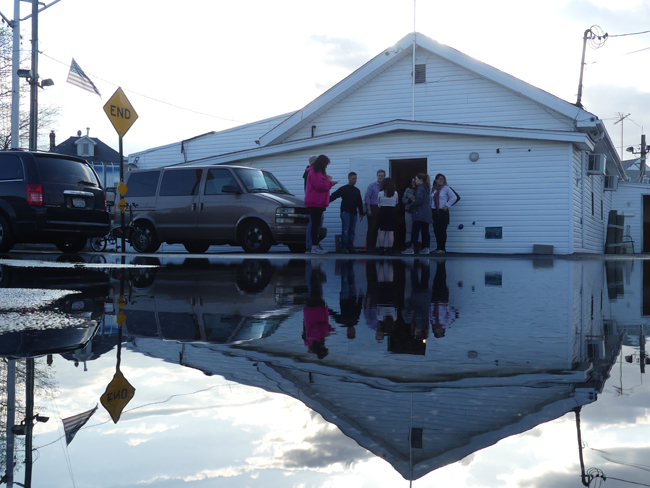
Sunny day flooding submerged the parking lot of the Howard Beach Motor Boat Club in a few inches of water. On the day of the flood forum, the tide level near the community of Howard Beach was about 7.5 feet above mean high tide. Credit: Ryan Strother / NYSG.
Contact:
Helen Cheng, NYSG's Coastal Resilience Extension Specialist, E: helen.cheng@cornell.edu P: (718)-951-5415
New York, NY, June 30, 2019 - Flooding doesn't only happen on bad weather days. The phenomenon of “sunny day flooding” is just as it sounds–the weather may have been sunny, dry and calm for a week and yet the rising tide works its way up through storm drains, flooding the streets with seawater. The parking lot of the Howard Beach Motor Boat Club turned into a reflecting pool with several inches of seawater on the evening of May 15th, 2019, coincidental with the Flood Forum designed to provide resources for community members to prepare for the risks and challenges of coastal homeownership in the face of rising seas and a changing climate. The impact of the flooding was tangible as attendees removed shoes and socks to wade through the parking lot to the entrance.
Flooding poses significant risks to coastal communities in south Brooklyn and Queens, but it is just one of several challenges facing New York City’s coastal communities. Professionals from a variety of resilience-focused agencies gave short presentations on homeowner preparedness.
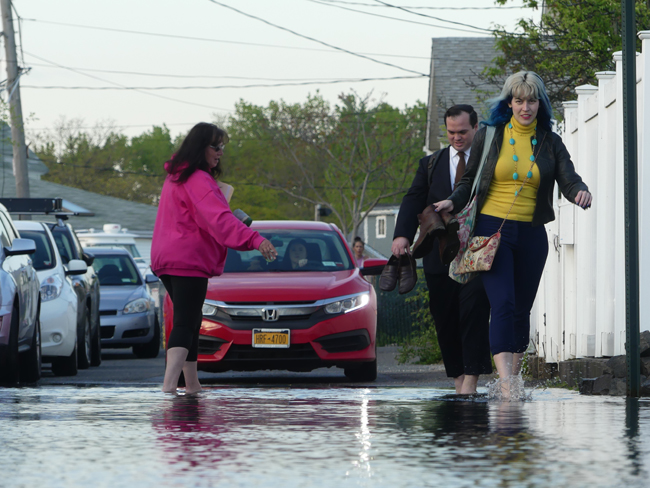
Some attendees of the Flood Forum removed shoes and socks to wade through the parking lot flooding. Credit: Ryan Strother / NYSG.
Fortunately, most flooding events do not come as a surprise thanks to forecasting. Philip Orton from the Stevens Institute of Technology presented on flood forecasting and preparedness. The Stevens Institute forecasts through the Stevens Flood Advisory System utilizes several weather forecasts and data inputs to provide a flood prediction with an error of about a food, with 90% confidence mark, meaning that only about 10% of the time do tides fall outside of the predicted range. Orton explained that on the day of the forum, the Stevens Institute was able to predict a tide level near Howard Beach at about 7.5 feet above mean high tide, which predicted the sunny day flooding event.
Orton explained how to gather information for potential flooding and weather events. When a storm is approaching, Orton recommended first looking to the National Weather Service (NWS) flood forecasts, which are typically seen on TV via the weathermen or distributed by the New York City Office of Emergency Management (NYCOEM). It’s also important to adhere to NYC guidance for evacuation notices. NYC looks to the NWS and Stevens models to guide their decisions. And, for more technical details, you can take a look at the Steven’s forecasts and models yourself. The Stevens Institute forecast system can help predict local flooding events as far as four days in advance.
Sol Posada from the New York City Department of Environmental Protection (DEP) presented on the city’s storm infrastructure and how that impacts homeowners during rain events. There are over 7,500 miles of sewer system in the city, and 65% of the infrastructure collects storm water and sewer inputs in a combined system. During severe precipitation events, this combined system is subject to getting overwhelmed.
As a result, the DEP suggests adding check valves and other backwater protection to your home. During heavy rain events, basement plumbing fixtures like toilets, sinks, and drains may become vulnerable to an overwhelmed sewer. If water from the city sewer rises to the level of basement plumbing, home toilets, sinks, and drains may back up into your home. Check valves or plugs can protect your home from this risk during weather events.
Reducing stormwater runoff may also help mitigate damage caused by overwhelmed storm drains. Green areas, porous concrete, and unpaved spaces help reduce flows into the sewer by reducing stormwater runoff your property sends to sewers. If the possibility of a flooding event arises, it is important to protect areas in your home below street level and the anticipated waterline. Sealing cracks in foundation walls, using barriers, and flood walls around doors and gates at driveway entrances may help reduce flood damage.
A number of individual actions can have big impacts on community resilience when added up. It’s important to keep grease out of the sewers—improper disposal of grease can clog your home’s pipes and city sewers. Also important is keeping catch basin grates clear. Keeping litter off of the street ensures proper stormwater flow.
Jill Cornell from NYCOEM gave attendees an overview of warning systems. The Howard Beach community is in coastal evacuation zone 1. It’s important for everyone, especially people in especially at-risk communities to sign up for Notify NYC to stay up to date with weather warnings and evacuation notices.
Another key component of resilience is flood insurance. Jennifer Leisure from FloodHelpNY, an organization engaging and informing New York City homeowners about how they can protect their home and finances from flooding that is expected to worsen with rising sea levels caused by climate change. presented on the importance of flood insurance, as well as the implications of a redrawing of flood risk maps with implications for mandatory flood insurance. Leisure also introduced FloodHelpNY’s backwater valve exchange program, which provides eligible homeowners with help installing a backwater valve to prevent in-home flooding.
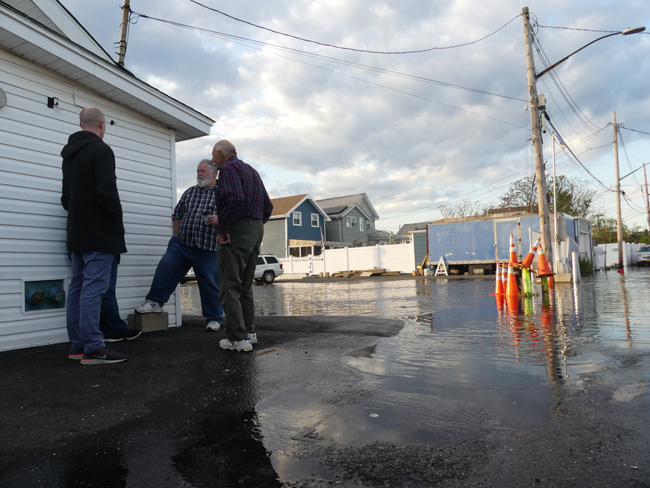
Howard Beach community organizers chat with the Science and Resilience Institute at Jamaica Bay Staff outside of the Flood Forum at the Howard Beach Motor Boat Club. Credit: Ryan Strother / NYSG.
The climate and flooding challenges facing Jamaica Bay communities is daunting, but there are many resources for communities to get active and involved in resiliency work. Helen Cheng, NYSG’s Coastal Resilience Specialist spoke about the importance of awareness. “The more we raise awareness on flooding, where it is happening and how it impacts people’s homes and sense of security, the better prepared we will be to mitigate these physical and mental impacts of flooding,” said Cheng.
Cheng introduced the Jamaica Bay Community Flood Watch Program, a community - citizen science program that encourages residents to report fooding in their communities. Citizens in New York City’s coastal areas can participate in the program by observing flooding events, and taking photos with observations of the weather, time of day, and other useful information useful to researchers. Participants then send in the photo, where it is uploaded into a database used to better understand flooding near Jamaica Bay. One of the goals of the project is to build relationships and partnerships with various groups, coastal communities, researchers, emergency managers, and agencies to address recurring flooding, raise awareness and build resilience to flooding.
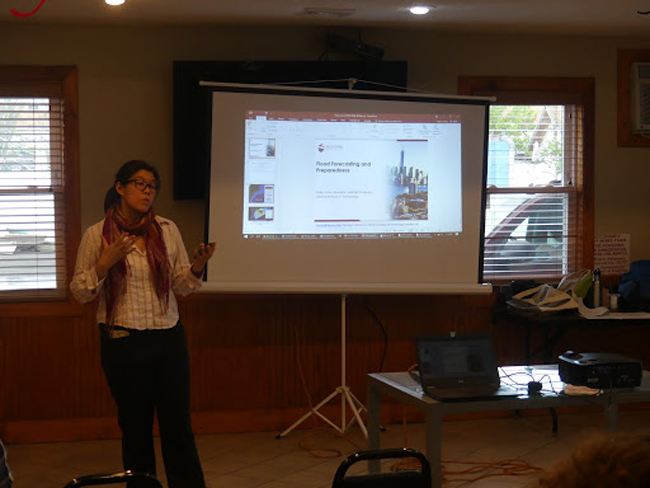
Helen Cheng, NYSG's Coastal Resilience Extension Specialist hosted the Flood Forum and provides outreach and flood preparedness resources for communities in NYC at risk for flooding events. Credit: Ryan Strother / NYSG.
Currently, the Jamaica Bay Community Flood Watch has records of flooding reports submitted by citizens since September 2018. That data is being organized spatially, where information about flooding events, dates, and locations will be accessible on a map. This citizen science project is supported through partnership with The Science and Resilience Institute at Jamaica Bay, New York City Mayor’s Office for Resiliency, New York City Emergency Management, and Stevens Institute of Technology.
To get involved in the citizen science and flood reporting, visit srijb.org/jbfloodwatch or contact Helen Cheng at helen.cheng@cornell.edu.
Here are some additional photos from this citizen science and flood reporting effort:
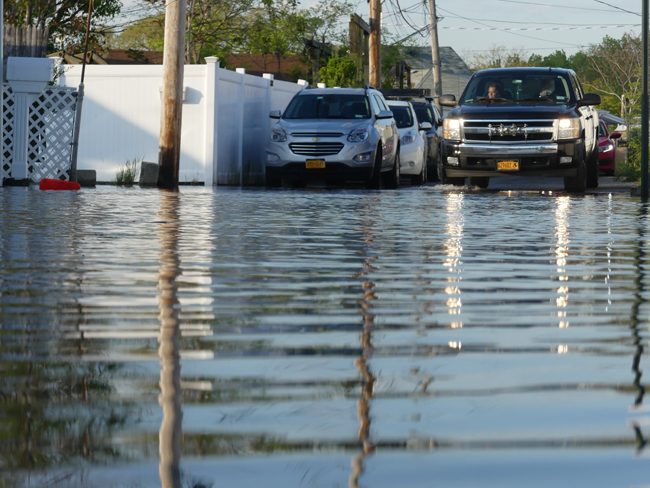
Credit: Ryan Strother / NYSG.
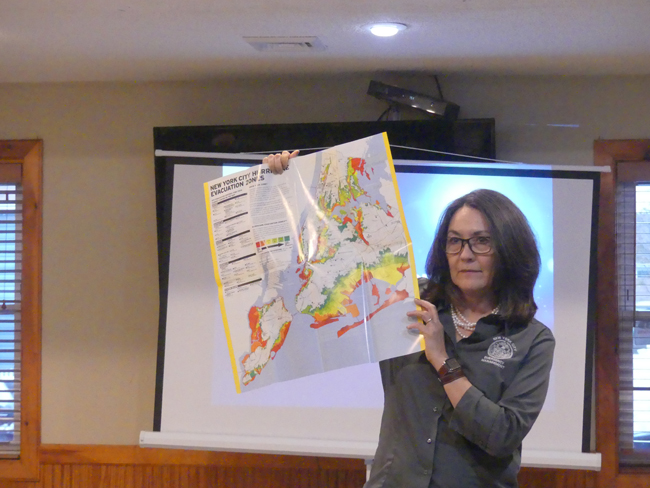
Jill Cornell from the New York City Department of Emergency Management presented information on flood zones and evacuation procedures. It is critical for NYC residents to know their flood risk zones and keep up to date with weather warnings and evacuation notices through Notify NYC. Credit: Ryan Strother / NYSG.
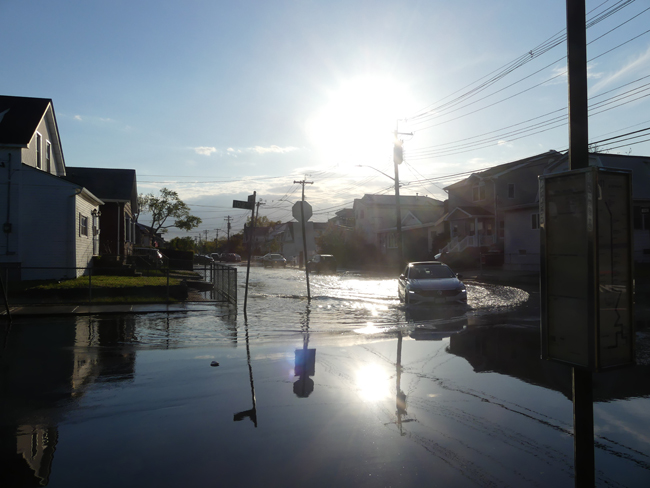
Sunny day flooding submerges the streets of Howard Beach and other coastal brooklyn communities when tidal conditions align and water enters the streets through storm drains. Forecasts from The Stevens Institute of Technology through the Stevens Flood Advisory System are able to predict flood events with a 90% confidence mark. Credit: Ryan Strother / NYSG.
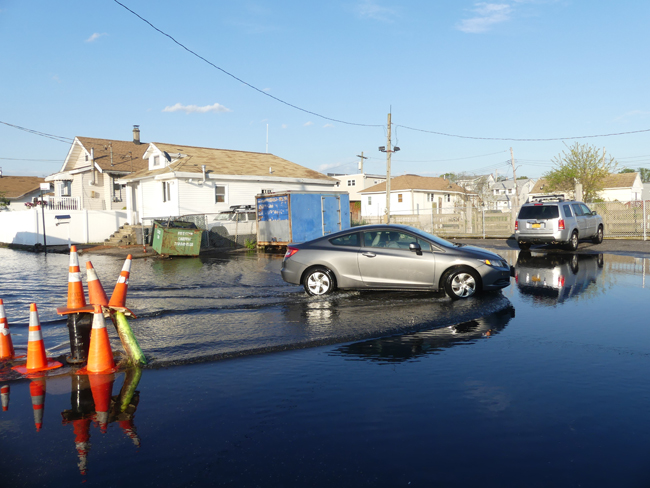
Credit: Ryan Strother / NYSG.
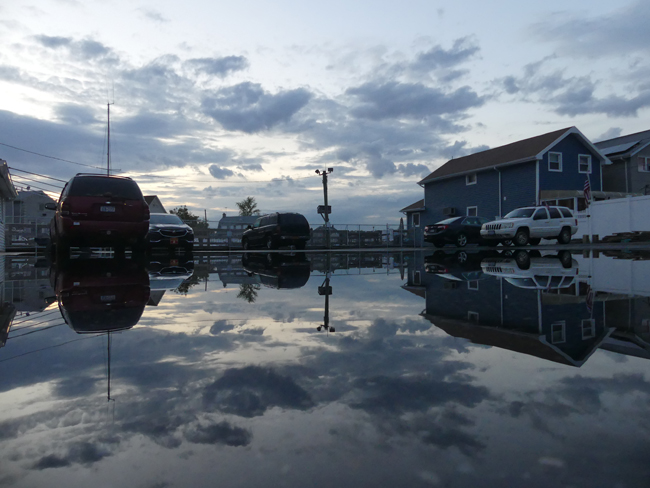
Credit: Ryan Strother / NYSG.
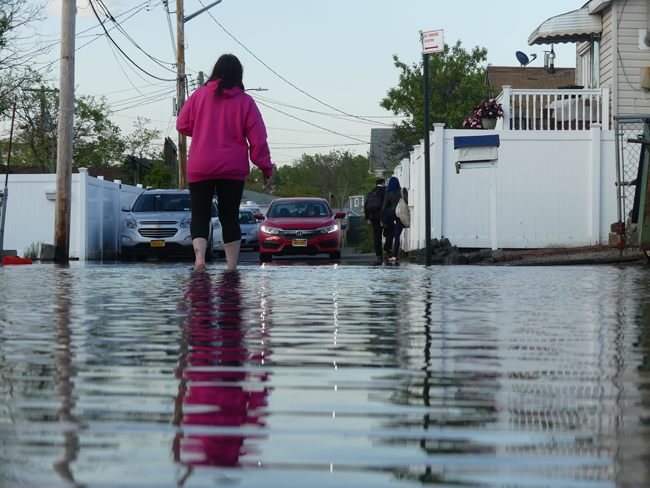
Credit: Ryan Strother / NYSG.
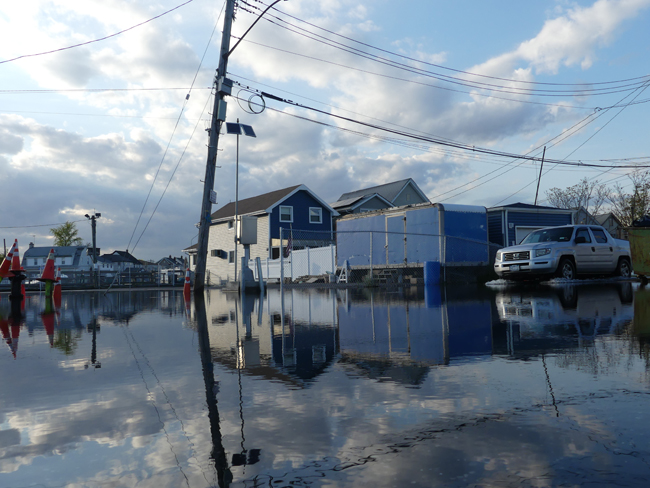
Credit: Ryan Strother / NYSG.
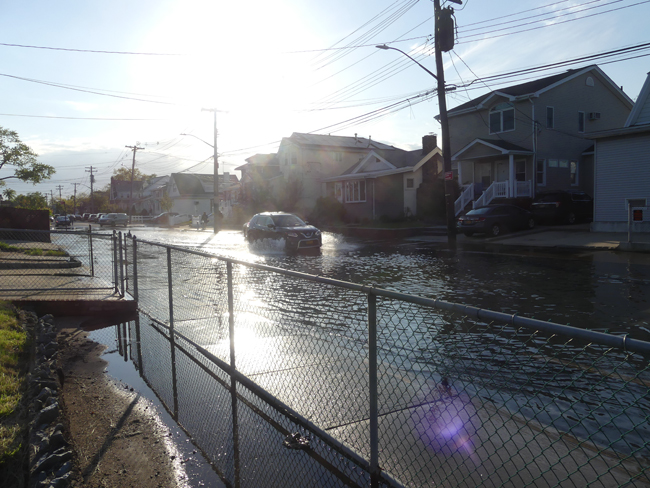
Credit: Ryan Strother / NYSG.
More Info: New York Sea Grant
New York Sea Grant (NYSG), a cooperative program of Cornell University
and the State University of New York (SUNY), is one of 33 university-based
programs under the National Oceanic and Atmospheric Administration’s
National Sea Grant College Program.
Since 1971, NYSG has represented a statewide network of integrated
research, education and extension services promoting coastal community
economic vitality, environmental sustainability and citizen awareness
and understanding about the State’s marine and Great Lakes resources.
Through NYSG’s efforts, the combined talents of university scientists
and extension specialists help develop and transfer science-based
information to many coastal user groups—businesses and industries,
federal, state and local government decision-makers and agency managers,
educators, the media and the interested public.
The program maintains Great Lakes offices at Cornell University, SUNY
Buffalo, SUNY Oswego and the Wayne County Cooperative Extension office
in Newark. In the State's marine waters, NYSG has offices at Stony Brook
University in Long Island, Brooklyn College and Cornell Cooperative
Extension in NYC and Kingston in the Hudson Valley.
For updates on Sea Grant activities: www.nyseagrant.org has RSS, Facebook, Twitter, and YouTube links. NYSG offers a free e-list sign up via www.nyseagrant.org/nycoastlines for its flagship publication, NY Coastlines/Currents, which is published quarterly. Our program also produces an occasional e-newsletter,"NOAA Sea Grant's Social Media Review," via its blog, www.nyseagrant.org/blog.